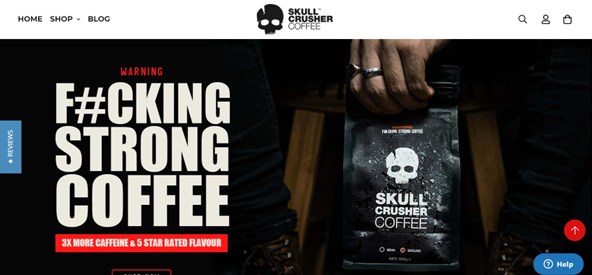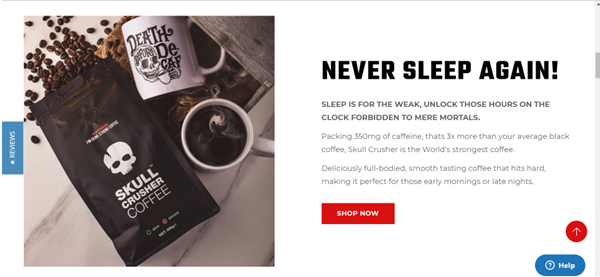“You know what?” Says Carol, clicking onto a website for that one specific item she wants to purchase.
“I’m so glad I’ve been bombarded with popups, the CEO’s story of how they started their business in Bali, and no obvious way to just get to where I fucking need to be!”.
Said no Carol (or anyone, for that matter) ever.
If you’re looking to move your customers from the top of the funnel to the bottom of the funnel with crap website copy, you’re only going to end up balding faster than Wayne Rooney from sheer stress… and let’s face it, you don’t have the money for a hair transplant.
Whether you lean heavily on social or email marketing, you’ll usually end up funnelling traffic to your website.
So are you funnelling traffic to the M60 of websites, or are you actually converting?
Here are the most common website copy mistakes and how to fix them.
First things first...
I mentioned the marketing funnel above for a reason – a customer won’t hop from not knowing anything about your business to a conversion in one step.
It’s called a customer journey for a reason, after all
You’re usually looking to target the following:
- Awareness: you’ll use a content strategy to raise brand awareness and create an audience receptive to your products/services, which can be done through social media, paid ads, and other relevant content mediums.
- Consideration: your audience has engaged with your brand in some capacity, whether they’ve signed up to a newsletter or follow you on social media. Now is when you work on building trust and showing some social proof, case studies, and giving value.
- Conversion: it’s time to utilise that attention and trust to convert your audience by giving them specific, targeted reasons to choose your business (e.g., trials/demos, testimonials, price comparison charts, FAQs)
If you don’t account for this in your wider content marketing strategy, your website copy won’t be able to convert so much as a piece of tumbleweed flying by.
A USP that’s not remotely unique
Even some of the best website copy will struggle to result in action from consumers/customers if you don’t know what your unique selling proposition (USP) is.
Think of it like this…
There are hundreds, if not thousands, of businesses out there just like yours – so why should an audience choose your business?
You don’t want to be generalisable.
Things such as high-quality products or great customer service aren’t specific enough to be an effective USP because they are just assumed to be the standard of service.
Keep in mind as well that being unique shouldn’t take priority over what your customers actually value.
Take Skull Crusher Coffee as an example:


They aren’t just coffee, they’re ‘f#cking strong coffee’, with ‘3x more caffeine’ and ‘5 star rated flavour’.
The USP of Skull Crusher Coffee is the high caffeine content, which is above the industry average, marketed as the world’s strongest coffee for those who want to stay awake for as long as possible.
It’s certainly much better than just saying something about how the coffee is brewed and assuming customers know enough about that process to be swayed by it!
This USP is great because it differentiates them from their competitors whilst also challenging them with the claim that their coffee blend is 3x stronger.
No awareness of pain points
Remember when I mentioned the customer journey?
Well, some of the worst website copy forgets that we often land on a website when we’re looking to avoid pain.
For example, someone is having bad neck and shoulder pains and therefore scrolls through Google looking for a better pillow to remove that pain point.
They don’t give a shit about your extensive material breakdown or where your products are shipped from (not yet, anyway).
What they care about is alleviating their pain
Do these pillows help align your posture so that your spine is in a neutral position (so you’ll never suffer with neck pain again?)
Are the pillows customised to you so that your specific ailments are being addressed so that you won’t be tossing and turning all night?
(I don’t know anything about pillows and neck or back pains… but you get my point.)
This individual already knows that they need something to address their pain point and it’s your job to give them their solution by addressing the issues they’re facing.
No balance between specifications and benefits
You might have seen some people on LinkedIn who are absolute advocates of benefits over specifications in every instance… but hear me out.
I, and your audience, want to know what’s in it for us on a personal level, sure.
But we kind of also want to know the specifications for a lot of products.
You’re not going to buy a laptop that’s only advertised as ‘Lightweight, superfast connection, more storage than you’ll know what to do with’, when you want to know the specifics like battery life, storage space, USB ports, RAM, HDMI, and all that technical shit that most of us pretend to understand when making a purchase.
Benefits and specifications should work together not in opposition
You want to tell your customers not only what a product/service can do for them, but how it’ll do it.
If a laptop is super lightweight, which is the benefit, then which materials are responsible for this, or what are the dimensions and weight?
If a laptop has a superfast connection, which specifications enable this?
Generic CTAs
‘Get in touch’ and ‘buy now’ will always have a time and a place.
But if you truly know your audience inside and out (as you should) you’ll know that they’re going to need a better call to action than that.
You need to tell your audience what the next step in their journey is, and try to keep it cohesive and consistent.
Landing pages and home pages will need multiple CTAs for the different stage in the copywriting journey, and these need to be clear in what the next steps are.
‘Get started for free’ (for free is always a great incentive, as are demos and trials).
‘Shop our bestsellers’ (this overrides the need for a customer to scroll through countless pages or filter out to best reviewed or most frequently bought products).
‘Book an obligation-free call’ (people like the idea of not having to commit to anything in a discovery call).
There’s nothing stopping you from a CTA that says ‘Let’s fucking go!’ if you think it’s relevant to your audience and the action they’re taking.
The most important thing to keep in mind is:
- You should be providing a clear action for customers to take
- Your CTA should be tailored to your audience and their potential barriers to action (e.g., do they want to trial a product first? Are they looking for an option to reduce their hesitance? Do they prefer a specific form of contact?)
- Your CTAs should be placed deliberately, not just at every gap on your website
Get it sorted
A good writer doesn’t translate to a good copywriter, hence these common mistakes.
If in doubt and you want it done right, don't do it yourself - ask us instead!

